
Arzachel is a relatively young lunar impact crater located in the highlands in the south-central part of the visible Moon, close to the zero meridian. It lies to the south of the crater Alphonsus, and together with Ptolemaeus further north the three form a prominent line of craters to the east of Mare Nubium. The smaller Alpetragius lies to the northwest, and Thebit is to the southwest along the edge of the mare.

Fra Mauro is the worn remnant of a walled lunar plain. It is part of the surrounding Fra Mauro formation, being located to the northeast of Mare Cognitum and southeast of Mare Insularum. Attached to the southern rim are the co-joined craters Bonpland and Parry, which intrude into the formation forming inward-bulging walls. The crater is named after Italian geographer Fra Mauro.

Albategnius is an ancient lunar impact crater located in the central highlands. It is named after the Muslim astronomer and scientist Muhammad ibn Jābir al-Harrānī al-Battānī, Latinized as Albategnius.
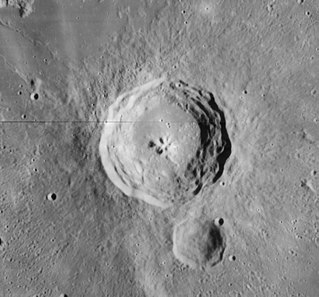
Bullialdus is a lunar impact crater located in the western part of the Mare Nubium. It was named after French astronomer Ismaël Boulliau. To the north by north-west is the broken-rimmed and lava-flooded crater Lubiniezky. South-west of Bullialdus lies the smaller crater König.

Deslandres is the heavily worn and distorted remains of a lunar impact crater. It is located to the southeast of the Mare Nubium, in the rugged southern highlands of the Moon. In dimension it is the third-largest crater formation on the visible Moon, being beaten only by Clavius and by the 303-kilometer-diameter walled plain Bailly. The northern and eastern parts of the floor display a relatively level surface, but it is pock-marked with numerous craters. There is a small region of mare material, due to basaltic lava, along the eastern interior floor.

Alpetragius is a lunar impact crater located on the eastern edge of Mare Nubium, to the southwest of the much larger crater Alphonsus. In the southeast is the prominent crater Arzachel, and to the west lies the flooded Lassell. Alpetragius is a Latinization of the name of Nur ed-Din al Betrugi, a Spanish-Arab astronomer.

Halley is a lunar impact crater that is intruding into the southern wall of the walled plain Hipparchus. Its diameter is 35 km. The crater is named after the English astronomer Edmond Halley. On the 1645 map by Michael van Langren, the crater is called Gansii, for the gansa of Francis Godwin's The Man in the Moone. To the southwest of Halley is the large crater Albategnius, and due east lies the slightly smaller Hind.
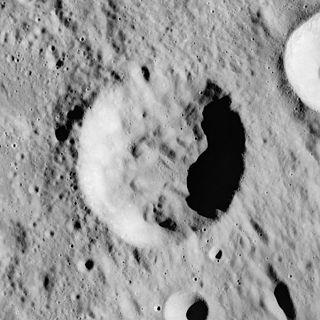
Hind is a lunar impact crater that lies to the southeast of the walled plain Hipparchus, and due east of the crater Halley. Its diameter is 29 km. It was named after British astronomer John Russell Hind. The rim of Hind is relatively free of wear and distortion, except for a break at the north rim. The floor of Hind is relatively uneven, however, compared to the interior of Halley. Hind and the craters Hipparchus C and Hipparchus L form a line with diminishing diameters that point to the northeast.
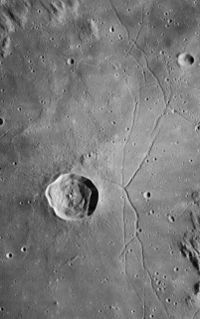
Triesnecker is a prominent lunar impact crater that is located in the Sinus Medii, near the central part of the Moon's near side. Its diameter is 25 km. It was named after Austrian astronomer Franz de Paula Triesnecker. It is located to the north-northwest of the crater Rhaeticus, and to the east-southeast of the flooded Murchison.
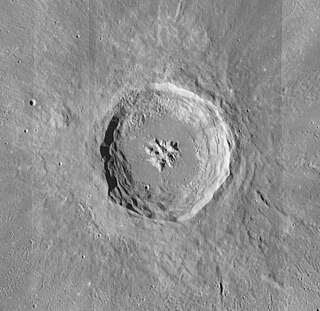
Aristillus is a prominent lunar impact crater that lies in the eastern Mare Imbrium. It was named after Greek astronomer Aristyllus. Directly to the south is the smaller crater Autolycus, while to the southwest is the large Archimedes. To the northeast are the craters Theaetetus and Cassini.

Dionysius is a lunar impact crater that lies on the western edge of the Mare Tranquillitatis. It was named after Dionysius the Areopagite. To the southeast is the crater pair of Ritter and Sabine. Just to the northwest is the system of rilles designated Rimae Ritter. These clefts follow a generally northwest direction.

Réaumur is the remains of a lunar impact crater located on the southern edge of Sinus Medii. Its diameter is 51 km. It was named after the 18th century French scientist René de Réaumur. It shares an eroded rim with the similar crater Oppolzer to the northwest. It lies to the northwest of the large walled plain Hipparchus, and east of Flammarion. To the south is Gyldén, and farther to the south-southwest is Ptolemaeus.

Bianchini is a lunar impact crater that lies along the northern Jura Mountains that ring the Sinus Iridum, in the northwestern part of the near side of the Moon. It was named after Italian astronomer Francesco Bianchini. The impact of this crater near the edge of the Jura Mountains deposited some material into the Sinus Iridum floor.
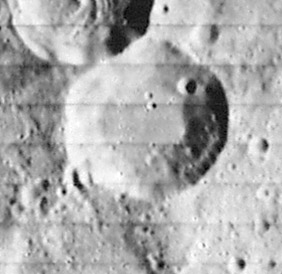
Azophi is a lunar impact crater that lies in the rugged south-central highlands of the Moon. The crater is named after the 10th-century Persian astronomer Abd Al-Rahman Al Sufi, also known by his western name, Azophi. The northwest rim is attached to the slightly smaller crater Abenezra, to the east-southeast is the large and irregular Sacrobosco, and to the west-southwest is the slightly crater Playfair.

Davy is a small lunar impact crater that is located on the eastern edge of the Mare Nubium. It was named after British physicist Humphry Davy. It overlies the lava-flooded remains of the satellite crater Davy Y to the east, a formation which contains a crater chain designated Catena Davy. To the southeast of Davy is the prominent crater Alphonsus.

D'Arrest is a lunar impact crater that is located in the lava-flooded region to the west of the Mare Tranquillitatis. It is named after the German astronomer Heinrich Louis d'Arrest. It lies to the southeast of the crater Agrippa and northwest of Delambre. Just to the northeast are the small, bowl-shaped craters De Morgan and Cayley.

Boussingault is a large lunar impact crater that lies near the rugged southeast limb of the Moon. Because of its location, Boussingault appears highly oblong in shape due to foreshortening. To the southwest is the crater Boguslawsky, and almost attached to the northeast rim is Helmholtz. East-southeast of Boussingault lies the crater Neumayer.

Daubrée is a lunar impact crater that is located to the southwest of the Mare Serenitatis, just to the west-southwest of the crater Menelaus in the Montes Haemus range. The small lunar mare Lacus Hiemalis lies along the southwest rim of Daubrée. The crater was named after French geologist Gabriel A. Daubrée. It was previously designated Menelaus S.

Gyldén is the remnant of a lunar impact crater that is located to the northeast of the walled plain Ptolemaeus on the Moon. Its diameter is 48 km. It is named after the Finland-Swedish astronomer Hugo Gyldén. It lies along the prime meridian of the selenographic coordinate system, and less than 150 km south of the lunar equator. Nearby craters of note include Herschel to the west, the flooded Réaumur to the north, and Hipparchus to the east.

La Pérouse is a lunar impact crater that is located near the eastern limb of the Moon. It lies northwest of the larger crater Ansgarius, and to the east of Kapteyn. This crater appears foreshortened due to its location, but the rim is nearly circular when viewed from orbit.
























